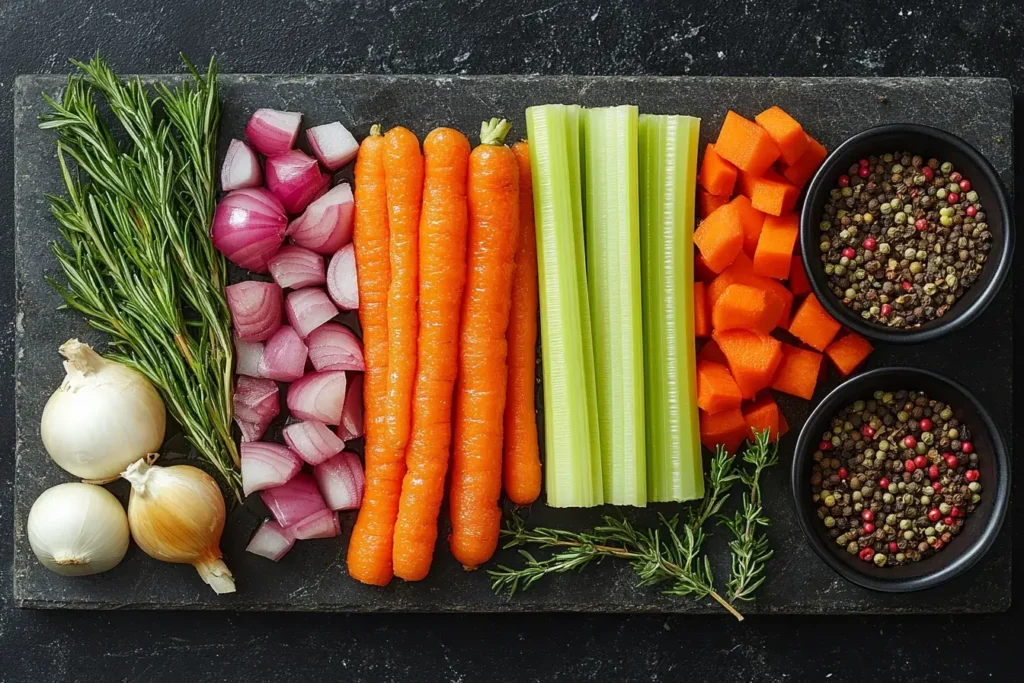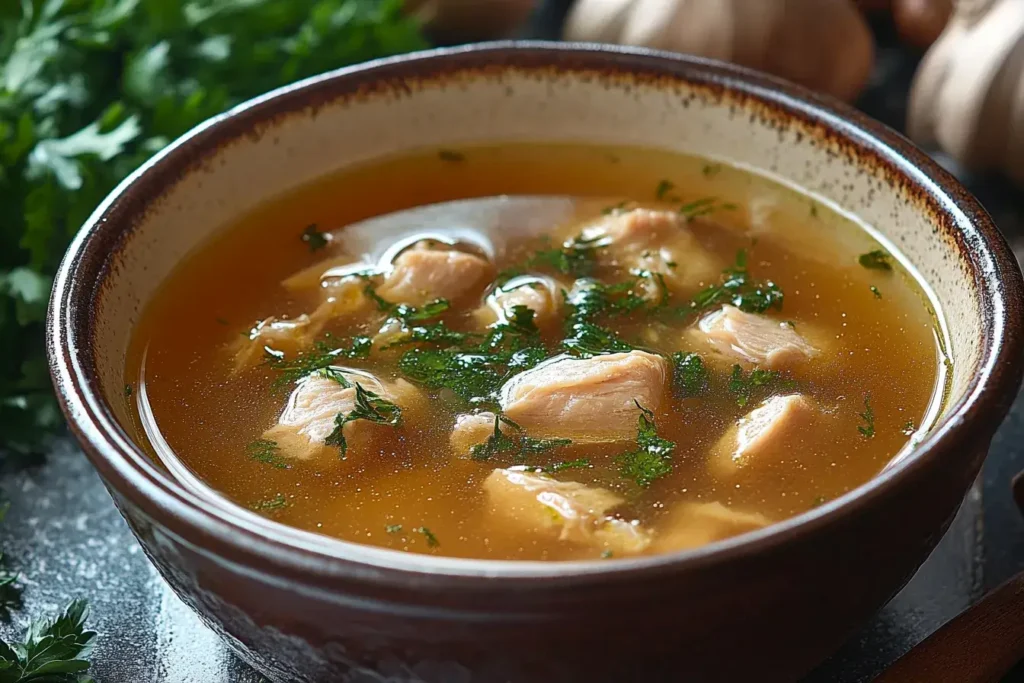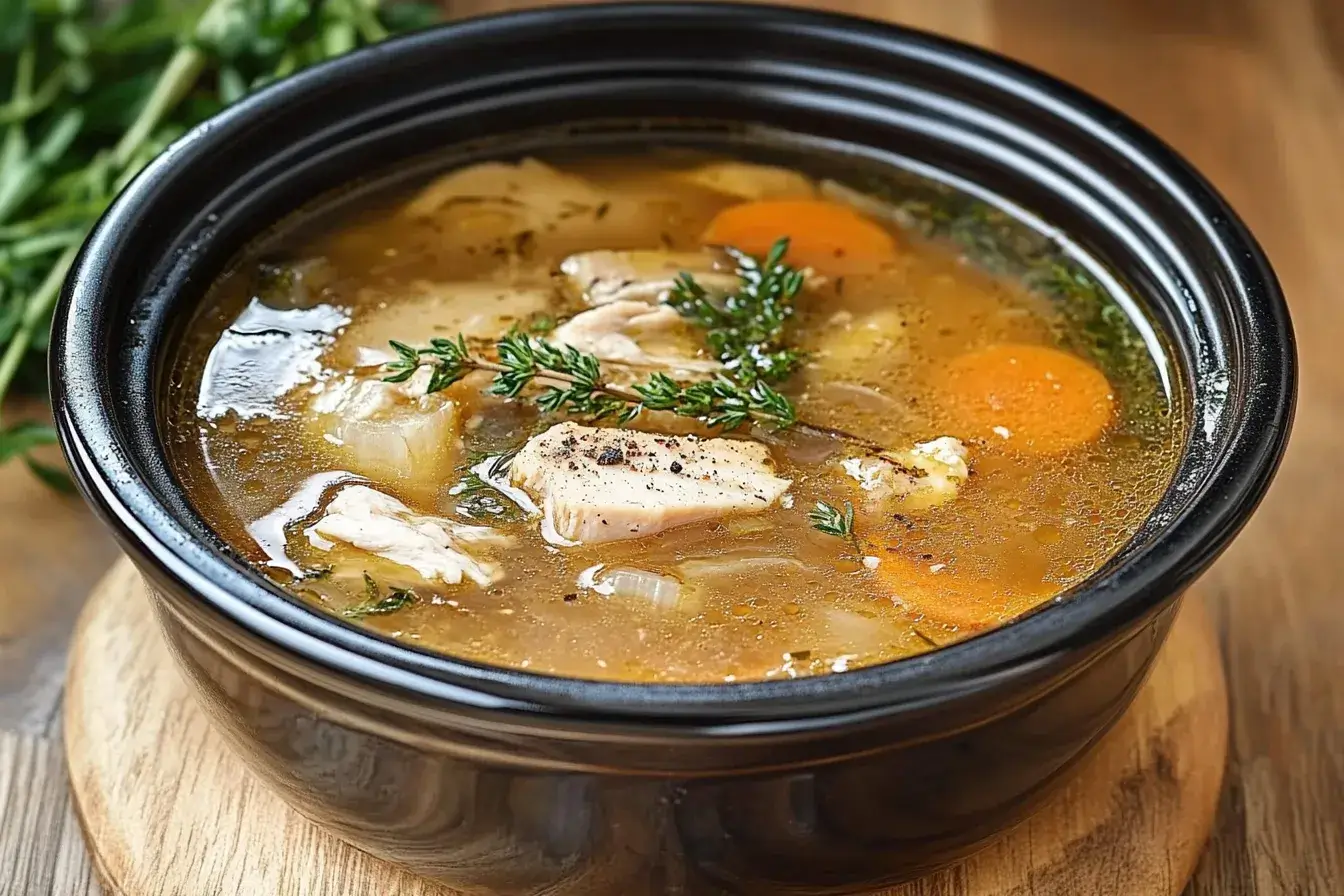Chicken bone broth has become a go-to recipe for those who cherish good health and crave rich, comforting flavors. This simple yet versatile elixir is loaded with nutrients and is often hailed as a superfood. In this guide, we’ll cover everything from the basics of making chicken bone broth at home to creative ways to use it in your meals. Whether you’re a seasoned cook or just starting, you’ll learn the ins and outs of crafting the perfect chicken bone broth recipe. Let’s dive right in!
Table of Contents
Introduction to Chicken Bone Broth
What is Chicken Bone Broth?
Chicken bone broth is a healthy, rich liquid made by cooking chicken bones, joints, and tasty ingredients for a long time. Unlike regular stock, bone broth is cooked longer to get all the nutrients from the bones. The result? A thick, flavorful liquid full of collagen, protein, and important minerals.
Health Benefits of Chicken Bone Broth
Why is everyone talking about chicken bone broth? It’s because this wholesome brew supports gut health, strengthens joints, and boosts immunity. Thanks to its high collagen content, it promotes glowing skin and healthy hair. Moreover, sipping warm bone broth is an excellent way to stay hydrated and nourished.
Why Make Bone Broth at Home?
Store-bought broths may be convenient, but they often fall short in flavor and nutrients. By making homemade chicken bone broth, you control what goes into the pot—ensuring no preservatives, additives, or excess sodium. Plus, you can tweak the recipe to suit your palate. It’s fresher, tastier, and more economical than any carton you’ll find on a store shelf.
Essential Ingredients for Chicken Bone Broth

Key Ingredients Explained
The foundation of any great chicken bone broth recipe is high-quality ingredients. Start with chicken bones, which can include the carcass, wings, necks, or even feet for added gelatin. Fresh or leftover roasted chicken bones work equally well. Beyond the bones, you’ll need vegetables like carrots, celery, and onions for a robust flavor. Don’t forget garlic and a splash of apple cider vinegar to help extract minerals from the bones.
Herbs and spices add depth. Consider bay leaves, thyme, parsley, and whole black peppercorns. Sea salt or kosher salt enhances taste but use sparingly to adjust later.
Optional Additions for Flavor
Boost the flavor profile with ingredients like ginger for a zesty kick or turmeric for an anti-inflammatory boost. Mushrooms or seaweed can also infuse the broth with extra umami and nutrients. These additions take the broth from simple to sensational.
Choosing the Best Bones for Broth
Quality matters. Opt for organic chicken bones or free-range chickens whenever possible. This ensures a cleaner broth without antibiotics or hormones. Visit local farmers’ markets or butchers to source the best ingredients.
How to Make Chicken Bone Broth
Step-by-Step Instructions for Beginners
Making chicken bone broth is easier than you think. Begin by roasting the chicken bones for 20–30 minutes at 400°F to deepen the flavor. Add the roasted bones to a large stockpot along with chopped vegetables, herbs, and apple cider vinegar. Cover everything with water, leaving room to prevent boiling over. Simmer on low heat for at least 12 hours—longer for richer broth.
Cooking Methods: Stove, Slow Cooker, Instant Pot
There’s more than one way to cook this culinary marvel:
- Stove Method: Simmer on low heat, skimming foam periodically.
- Slow Cooker: Let it simmer overnight for hassle-free results.
- Instant Pot: For quick preparation, cook under high pressure for 2 hours.
Each method delivers a delicious chicken bone broth recipe tailored to your schedule.
Tips for Perfect Broth Consistency and Taste
For a clearer broth, skim impurities regularly. Adding too much water can dilute the flavor, so maintain a balanced water-to-ingredient ratio. For a more gelatinous consistency, include chicken feet or wings. Adjust seasoning after simmering to taste.
Pro tip: Freeze leftover broth in ice cube trays for easy portioning later.
Nutritional Profile of Chicken Bone Broth
Calorie and Nutrient Breakdown
A chicken bone broth recipe isn’t just about flavor; it’s a nutritional powerhouse. A single cup is low in calories, typically around 30–50, making it ideal for those watching their intake. Yet, it’s rich in nutrients like calcium, magnesium, and potassium, essential for bone and muscle health.
What sets bone broth apart is its collagen and gelatin content. These compounds support joint health, improve digestion, and promote radiant skin. Additionally, amino acids like glycine and proline help repair tissues and boost the immune system.
Comparison: Store-Bought vs. Homemade
While store-bought options offer convenience, they often lack the depth and nutritional quality of homemade broth. Many commercial broths contain preservatives and lower levels of gelatin. With a homemade chicken bone broth recipe, you control every ingredient, ensuring maximum health benefits and flavor.
Pro tip: Homemade broth allows you to avoid unnecessary additives and customize the taste with your favorite herbs and vegetables.
Uses for Chicken Bone Broth in Everyday Cooking
Soups and Stews
The most obvious way to use chicken bone broth is as a base for soups and stews. Its rich, savory flavor enhances classics like chicken noodle soup or hearty vegetable stew. By replacing water with bone broth, you’ll boost both the flavor and nutritional value of your dishes.
Healthy Drinks and Smoothies
Sipping warm bone broth is a comforting, healthful alternative to tea or coffee. For a nourishing twist, blend it into savory smoothies with spinach, avocado, or turmeric. These drinks are perfect for post-workout recovery or as a mid-day pick-me-up.
Creative Recipes Using Bone Broth
Think beyond the bowl! Use chicken bone broth in casseroles, risottos, or even as a liquid base for cooking grains like quinoa. It adds depth to sauces and gravies and can be used to deglaze pans for extra flavor in stir-fries.
For more ideas on incorporating chicken into your meals, explore the recipe for Leftover Rotisserie Chicken Recipes, which pairs beautifully with chicken bone broth.
Storing and Reusing Chicken Bone Broth
Proper Storage Techniques
Storing your chicken bone broth recipe properly ensures it stays fresh and flavorful. Once cooled, transfer the broth to airtight containers. Glass jars or BPA-free plastic containers work well for short-term storage. Keep them in the fridge, where the broth will last up to five days. Always label the containers with the date for easy tracking.
Freezing for Long-Term Use
If you’ve made a big batch, freezing is the best way to preserve it. Pour the broth into freezer-safe bags, leaving some space for expansion, or use silicone ice cube trays for portioned servings. Frozen broth can last up to six months without losing quality. To thaw, transfer it to the fridge overnight or warm it gently on the stove.
Signs of Spoiled Broth
Spoilage can happen if the broth isn’t stored correctly. A sour smell, cloudy appearance, or unusual texture are red flags. When in doubt, throw it out. Proper storage not only preserves the broth’s flavor but also its health benefits.
FAQs About Chicken Bone Broth
How Long Should I Simmer Chicken Bone Broth?
For the best chicken bone broth recipe, simmering times matter. A minimum of 12 hours on the stove or in a slow cooker extracts the most nutrients and flavor. If you’re using an Instant Pot, two hours under pressure works wonders.
Can I Use Cooked Bones for Broth?
Absolutely! Using leftover bones from roasted or rotisserie chicken is a great way to reduce waste while making delicious broth. Simply add raw or roasted vegetables for extra flavor.
What’s the Difference Between Bone Broth and Stock?
The key difference lies in cooking time. Stock is typically simmered for a few hours and lacks the gelatin-rich texture of bone broth, which is simmered much longer. Bone broth is also more nutrient-dense, making it ideal for sipping or as a base in recipes.
Is Chicken Bone Broth Keto-Friendly?
Yes! Chicken bone broth fits perfectly into a keto diet. It’s low in carbs and rich in healthy fats and collagen. For added flavor, mix it with herbs or keto-friendly seasonings.
For even more kitchen inspiration, consider trying this Chopt Spicy Chicken Soup Recipe with Rice, which complements homemade bone broth beautifully.
Conclusion and Final Thoughts

Recap of Benefits and Steps
Creating a homemade chicken bone broth recipe is more than just a culinary activity it’s an investment in your health. With its rich flavors and high nutritional value, bone broth is a versatile addition to your kitchen. From supporting digestion to boosting joint health, this humble broth is packed with benefits.
The process is simple: gather quality ingredients, simmer them for hours, and store the liquid gold for later use. Whether you’re using it as a soup base, sipping it warm, or adding it to creative recipes, the possibilities are endless.
Encouragement to Experiment with Recipes
Don’t hesitate to personalize your chicken bone broth recipe. Add herbs, spices, or vegetables that suit your taste. Experiment with cooking methods to find what works best for your lifestyle. Remember, each batch is an opportunity to create a flavor that’s uniquely yours.
If you’re inspired to explore more, consider pairing your broth with hearty meals like stews or casseroles. It’s time to grab those chicken bones and start simmering!
Bonus Tips for Perfecting Your Bone Broth
Choosing the Right Tools
Using the right tools can make your chicken bone broth recipe foolproof. A large stockpot or slow cooker ensures even cooking. For an Instant Pot, follow the recommended pressure settings for optimal results.
Enhancing the Flavor
To elevate your broth’s taste, try roasting the bones beforehand or adding a dash of vinegar. Fresh herbs like thyme or rosemary can provide an aromatic boost. For a deeper umami flavor, throw in mushrooms or seaweed.
Adapting for Special Diets
Bone broth is naturally gluten-free, keto-friendly, and paleo-approved. However, you can adjust ingredients to fit vegan or vegetarian diets by substituting chicken bones with nutrient-dense vegetables and seasoning them with savory spices.
Encouragement to Share
Sharing your homemade chicken bone broth recipe with friends or family is a wonderful way to connect over food. Package it as a thoughtful gift or teach someone else how to make their own. Spread the love—and the benefits—of this timeless comfort food.

